
Airplane Wing Diagram
A diagram of wing airplane illustrating the skeleton. The shape of the wing creates a lift—draft…

Pusher Aeroplane Plan
A plan for pusher aeroplane, or airplanes. The propeller of the pusher plane is located behind the cockpit…

Propeller Aeroplane Side Plan
A propeller airplane plan illustrating the proper location of the skeleton and placement of the wires…
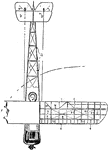
Propeller Aeroplane Top Plan
A top view plan of a propeller aeroplane, or airplane. The plan shows the proper ribs and skeleton for…

Full Megatherium Fossil Skeleton
A full fossil skeleton of the Megatherium, an elephant sized ground sloth. The animal was extinct during…

Lower Jaw of Megatherium Fossil Skeleton
The lower jaw and teeth of the Megatherium, elephant sized sloth. The teeth are quandrangular, or triangular…
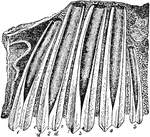
Upper Molar Teeth of Megatherium Fossil Skeleton
Illustration showing the upper molar teeth of the megatherium, a giant sloth. The teeth were 7 to 8…

Chacma Baboon Skeleton
"The skeleton, more especially in the higher forms, is in the main similar to that of man, so that only…
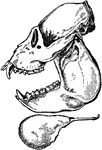
Side View of Howler Monkey
A side view of the howler monkey skull. The monkey have four sharp canines, long teeth on skull, on…
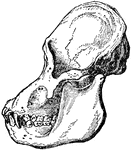
Adult Male Orangutan Skull Viewed from Side
An illustration of an adult male orangutan viewed from the side. The orbit part of the skull is more…
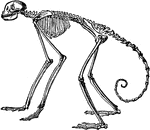
Side View of Skeleton of South American Spider Monkey
"In the other forms the number (vertebrae) varies between twenty and thirty three, the latter being…

Front View of Gorilla Skeleton
"The greatest absolute length of the fore—limb occurs in the gorilla and the orangutan. The humerus…

A Prehistoric Egyptian Tomb
"The skeleton lay on the left side with knees drawn up and hands raised to the head. About it were various…

Skeleton of the Deer
"The bones in the extremities of this the fleetest of quadrupeds are inclined very obliquely towards…
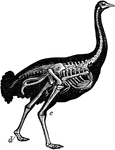
Skeleton of Ostrich
"Shows the powerful legs, small feet, and rudimentary wings of the bird; the obliquity at which the…

Skeleton of Opuntia Stem
Illustrated is a skeleton of an opuntia stem. These skeleton stems are sometimes made into walking-sticks.
Spooky Hootenanny
The Skeleton asked his friends, "Do you think this is a gathering, a shindig, or a hootenanny?" The…
Acipenser Sturio
A type of Ganoid fish. Ganoid is an order of fishes included seven living genera, whose members are…
Amia Occidentalis
A type of Ganoid fish. Ganoid is an order of fishes included seven living genera, whose members are…

Human Leg (Front View), and Comparative Diagrams showing Modifications of the Leg
This illustration shows a human leg (front view), and comparative diagrams showing modifications of…
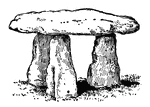
Lanyon Quoit Dolmen
Lanyon Quoit is a dolmen near Penzance. A dolmen, also known as a cromlech, portal tomb, portal grave…

Shackle Joint from the Exoskeleton of a Siluroid Fish
"A joint involving the principle of the shackle. Specifically, in anatomy, a kind of articulation found…

Bones of the Shoulder and Upper Extremity - Front View
"A, acromion; C, coracoid; CA, carpus; CL, clavicle; H, humerus; M, metacarpals; O, ventral surface…

Armadillo - Endoskeleton and Exoskeleton or Dermoskeleton
An illustration of a pichiciago, a small burrowing armadillo. The front half of the animal is covered…
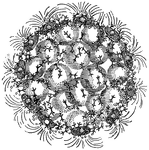
Sphaerozoum Ovodimare
"A genus compound radiolarians, typical of the family Sphaerozoidae, the protoplasm of which contains…



